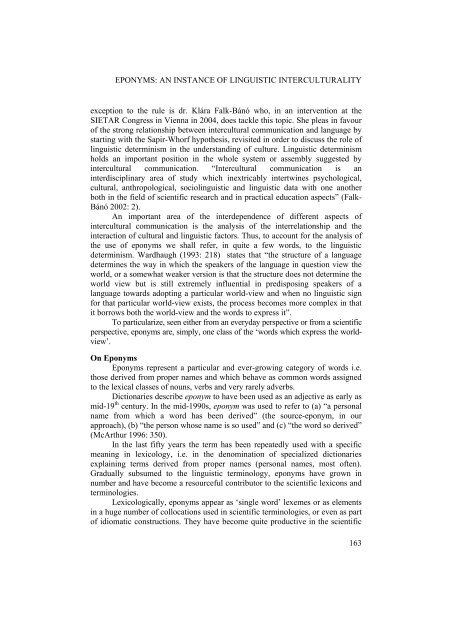culture, subculture and counterculture - Facultatea de Litere
culture, subculture and counterculture - Facultatea de Litere
culture, subculture and counterculture - Facultatea de Litere
Create successful ePaper yourself
Turn your PDF publications into a flip-book with our unique Google optimized e-Paper software.
EPONYMS: AN INSTANCE OF LINGUISTIC INTERCULTURALITY<br />
exception to the rule is dr. Klára Falk-Bánó who, in an intervention at the<br />
SIETAR Congress in Vienna in 2004, does tackle this topic. She pleas in favour<br />
of the strong relationship between intercultural communication <strong>and</strong> language by<br />
starting with the Sapir-Whorf hypothesis, revisited in or<strong>de</strong>r to discuss the role of<br />
linguistic <strong>de</strong>terminism in the un<strong>de</strong>rst<strong>and</strong>ing of <strong>culture</strong>. Linguistic <strong>de</strong>terminism<br />
holds an important position in the whole system or assembly suggested by<br />
intercultural communication. “Intercultural communication is an<br />
interdisciplinary area of study which inextricably intertwines psychological,<br />
cultural, anthropological, sociolinguistic <strong>and</strong> linguistic data with one another<br />
both in the field of scientific research <strong>and</strong> in practical education aspects” (Falk-<br />
Bánó 2002: 2).<br />
An important area of the inter<strong>de</strong>pen<strong>de</strong>nce of different aspects of<br />
intercultural communication is the analysis of the interrelationship <strong>and</strong> the<br />
interaction of cultural <strong>and</strong> linguistic factors. Thus, to account for the analysis of<br />
the use of eponyms we shall refer, in quite a few words, to the linguistic<br />
<strong>de</strong>terminism. Wardhaugh (1993: 218) states that “the structure of a language<br />
<strong>de</strong>termines the way in which the speakers of the language in question view the<br />
world, or a somewhat weaker version is that the structure does not <strong>de</strong>termine the<br />
world view but is still extremely influential in predisposing speakers of a<br />
language towards adopting a particular world-view <strong>and</strong> when no linguistic sign<br />
for that particular world-view exists, the process becomes more complex in that<br />
it borrows both the world-view <strong>and</strong> the words to express it”.<br />
To particularize, seen either from an everyday perspective or from a scientific<br />
perspective, eponyms are, simply, one class of the ‘words which express the worldview’.<br />
On Eponyms<br />
Eponyms represent a particular <strong>and</strong> ever-growing category of words i.e.<br />
those <strong>de</strong>rived from proper names <strong>and</strong> which behave as common words assigned<br />
to the lexical classes of nouns, verbs <strong>and</strong> very rarely adverbs.<br />
Dictionaries <strong>de</strong>scribe eponym to have been used as an adjective as early as<br />
mid-19 th century. In the mid-1990s, eponym was used to refer to (a) “a personal<br />
name from which a word has been <strong>de</strong>rived” (the source-eponym, in our<br />
approach), (b) “the person whose name is so used” <strong>and</strong> (c) “the word so <strong>de</strong>rived”<br />
(McArthur 1996: 350).<br />
In the last fifty years the term has been repeatedly used with a specific<br />
meaning in lexicology, i.e. in the <strong>de</strong>nomination of specialized dictionaries<br />
explaining terms <strong>de</strong>rived from proper names (personal names, most often).<br />
Gradually subsumed to the linguistic terminology, eponyms have grown in<br />
number <strong>and</strong> have become a resourceful contributor to the scientific lexicons <strong>and</strong><br />
terminologies.<br />
Lexicologically, eponyms appear as ‘single word’ lexemes or as elements<br />
in a huge number of collocations used in scientific terminologies, or even as part<br />
of idiomatic constructions. They have become quite productive in the scientific<br />
163












